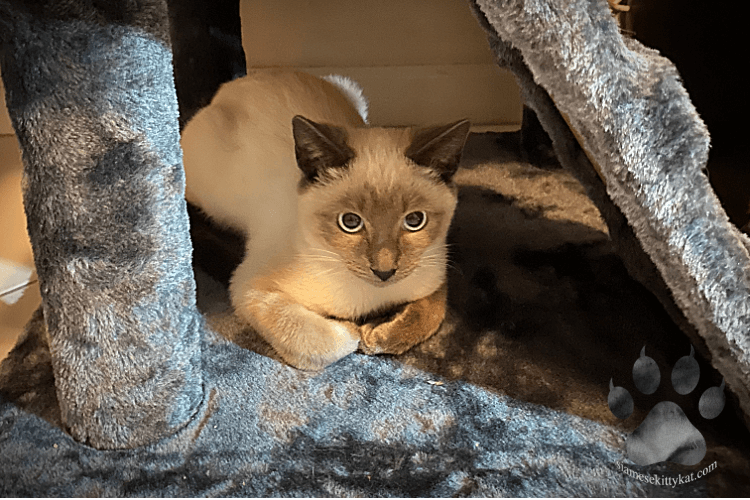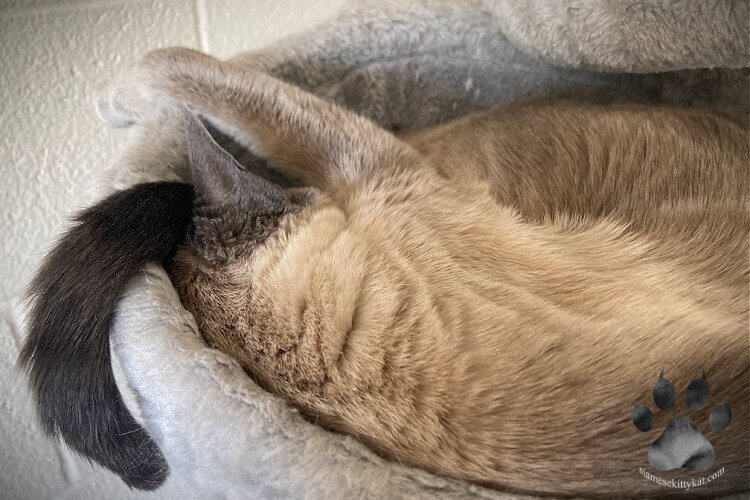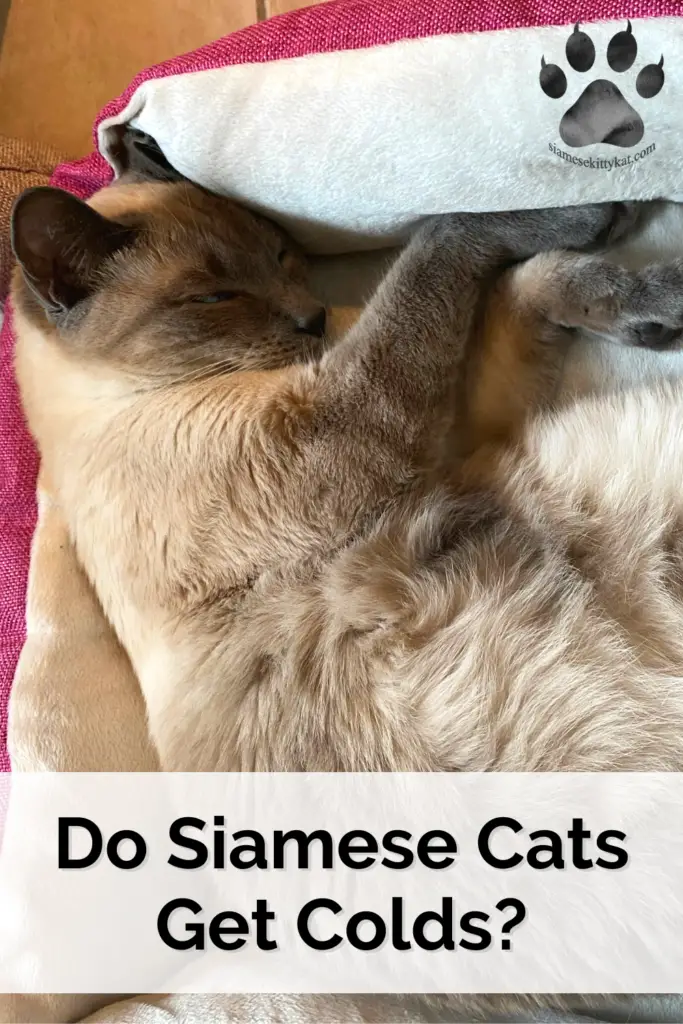Cats, like other mammals, have heat-regulating bodies. But, because the weather is often changing, cats do not tolerate heat as well as humans. It’s a good thing they have fur to keep them warm when it gets cold. But what about the Siamese breed? They have short coats. Do Siamese cats get cold? Are they vulnerable and particularly prone to cold?
Siamese cats can get cold. Like other types of cats, Siamese cats are prone to colds. Siamese cats cannot tolerate cold temperatures well. Your cat may develop cold symptoms if you don’t make appropriate preventative efforts.
This blog post answers people’s usual questions about why cats get colds. Read on to know what makes a Siamese cat get a cold. Plus, I’ve got suggestions for what you can do at home to help your sick cat.
What are the symptoms of a Siamese cat having a cold?
Symptoms that your cat might have a cold include:
In severe cases, you may also see:
Siamese cats experience cold symptoms within 7 to 10 days. Symptoms should disappear on their own within that period. If symptoms don’t go away, take your cat to the vet.
What causes a Siamese cat to get a cold?

90% of cat colds are due to Feline Herpesvirus and Feline Calicivirus. First, let’s get familiar with these two infections.
1. Feline herpesvirus (FHV, FHV-1)
Feline herpesvirus (FHV, FHV-1) is a virus causing respiratory infections. This virus is everywhere, and it makes cats sick all over the world.
Siamese cats affected by the disease become infected carriers. They can get the virus back when stressed. FHV can also cause eye issues in cats. The virus moves from one cat to the next through direct contact and staying in infected areas. Infected cats carry the virus for their whole lives. Many cats have no problems with this and don’t spread the virus fast. Sharing bowls and litter trays are also factors.
Typical signs and symptoms include:
In more severe cases, cats may have:
Severe symptoms of the FHV infection can be fatal. Especially for kittens and cats with weak immune systems and pre-existing medical conditions. Most cats with FHV symptoms recover in 10-14 days following supportive treatment.
2. Feline Calicivirus (FCV)
Feline Calicivirus infection is prevalent in cats. Up to 8 percent of domestic cats and 25 percent of shelter cats shed Feline Calicivirus. The statistics are according to the University of Wisconsin Madison (Shelter Medicine). Check this post for more scientific details about FCV.
Feline Calicivirus is chronic. 50% of sick cats shed FCV 75 days after recovery. Cats infected by FCV can shed for years or a lifetime. Cats that shed all the time can spread infections. 80% of FCV-infected cats can become chronic carriers. As cats improve, they produce less drool and snot. The risk of the virus spreading decreases.
Signs and symptoms in their acute form:
In severe cases, these symptoms may appear:
Most cats get better after suffering from Calicivirus. Most (but not all) cats recover from acute sickness in 7-10 days. In severe cases, FCV can be fatal to kittens and cats whose immune systems aren’t strong enough.
Do Siamese cat colds go away on their own?
In most cases, the clinical symptoms of a cat’s cold resolve within a week. Siamese cats can get over colds in 7 to 10 days. But if owners do not check and care for their cats, colds can cause further complications. You should take your furry buddy to the vet if your cat’s cold doesn’t go away for more than a week. Don’t wait until the symptoms get worse.
How can I help my cat’s cold at home?

1. Make a meal plan for your Siamese cat.
Chicken and rice can help make sick cats feel better. The food combination is a great meal to help their stomach feel relieved too. Chicken and rice have a bland flavor. Your cat will not vomit it up. Chicken and rice contain enough calories and nutrients to help your cat bounce back.
I offer small servings of chicken soup when one of my cats feels sick. Ensure it’s cool before serving if you want to do the same. Sometimes I pour some water from a drained tuna can on their cat food. Your vet can also give you a special prescription diet to help your cat feel better through the cold.
Moreover, vets recommend syringes for cats who have a hard time due to losing appetite. The sodium content of store-bought broths is pretty high. Some of these store-bought broths may contain onion and garlic. These two ingredients are unsuitable for your cat’s health. If you want to use chicken broth, only use homemade chicken broth.
Many cat owners feed their sick cats baby food. Gerber’s Chicken with Gravy baby food is a favorite among cat owners. If your cat has a cold, your furry baby might not want to eat. Stay close to them as they eat. My cat is more likely to eat whenever I sit with my sick cat and assist. Siamese cats find comfort in being with us.
2. Give the oral medicine your vet has prescribed on time.
Make sure you don’t forget to give your cat its oral medication at the specified time. I use my phone to remind me when it’s time to give my cat the medicine. It helps me ensure I give it at the right time and don’t leave anything out.
Oral medications can come in pill, capsule, or liquid form. It isn’t always easy to give a cat medicine by mouth. Do you agree? If it’s hard to give your cat a pill or capsule, ask your vet about suspending it in liquid. Before you dissolve a pill or capsule, ask your vet first. Some medicines can lose their effect if you stop taking them.
3. Keep the bed for your Siamese cat close by and away from the noise.
Cats become more anxious when they have a cold. Don’t put your cat’s bed near the TV, the washing machine, or the furnace. The noises from the appliances might scare them. If you need to move the bed, do it little by little. Move the bed a few inches until it gets to where you want it to be. Your sick cat might get startled if you move the bed far away. Cats are susceptible to random changes in their safe space.
4. Put the litter box(es) in quiet, private corners that are easy to get to for your Siamese cat.
Place the litter box in a free, searchable area. Cats need to see where they need to go to the potty. Use any light to brighten up the litter box area. Also, don’t forget to put the litter box away from your cat’s food and water bowls.
5. Don’t let your Siamese cat out of the house.
Your Siamese cat will be more relaxed and calm indoors. Closing shades, curtains, and doors can help your cat feel comfortable. Ensure your Siamese cat has access to a warmer area to prevent your cat from getting too cold.
6. Use a humidifier.
A cold can cause watery eyes, runny nose, and sneezing in your cat. A humidifier can help. Increasing the humidity will help your sick cat breathe better. Using a humidifier will help your Siamese cat feel better from the effects of a cold. Vets say your cat can sit in front of the humidifier for 30 minutes a day for two or three days.
7. Keep your cat nearby in the bathroom while you shower.
The humidity can relieve and help clear up your Siamese cat’s stuffy nose. Your cat’s nasal passages can stay moist by being in the shower. Be careful not to startle your Siamese cat when you turn on the shower. Your furry baby might get anxious from the sudden noise.
8. Use pheromone products.
Your Siamese cat feels stressed when sick. Products containing synthetic cat pheromones can help to calm your sick cat. Synthetic pheromones don’t hurt cats in any way.
Pheromones are natural treatments with no known side effects. Pheromone products provide cats with a sense of safety and relaxation. They have no sedative effect either. Ask for your vet’s advice before giving your Siamese cat synthetic pheromones.
Key points to keep in mind:
What can I do to keep my Siamese cat from getting cold?
Vaccinations are necessary for your cat. Although the vaccine does not deter cat herpes, it reduces infection. It would be best if you vaccinate your cat. Vets say the best time to start vaccination on your kitten is between 6 and 8 weeks. Also, your cat should receive a booster vaccine at the age of one year. Don’t forget about the following yearly boosts, either!
Also, keep your Siamese cat feeling loved. Remember how your cat rubs his cheek on your legs? Your cat does so as a sign of his great love for you! Give your cat the same kind of affection. Show the best love language you can give! Be there for your cat when he’s sick with a cold.
Thanks for reading!
We gathered all the health tips tailored toward maintaining your Siamese cat’s optimal well-being. Check it out here: Siamese Cat Health: A Complete Guide
Get your FREE Siamese Cat 2025 Printable Calendar

